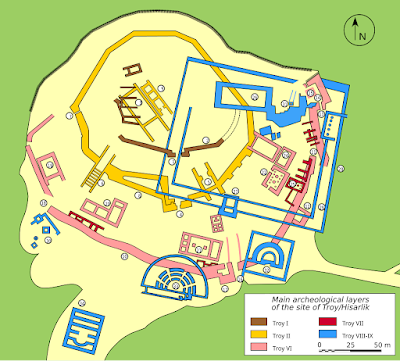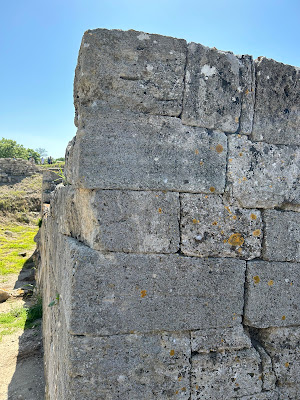The Illiad represent the effective beginnings of Western Literature. Dated roughly to the 8th Century B.C., it recounts part of the legendary 10 year war between the Greeks and their opponents the Trojans in the city of Troy. The story itself alludes to an older period of Greece rather that the end of the Dark Ages and entry into the Classical Era of Greek History. The Greeks treated it as history and the heroes - Achilles, Menelaus, Patrocles, Odysseus - as real historical characters. Alexander the Great was said to sleep with a copy of The Illiad by his bed and allegedly, copying Achilles, was the first to jump from the boat to Asia. But sometime between that period and later years, Troy was lost to ages, a legend and myth which inspired Greek Literature and therefore indirectly, Western Civilization.
 |
| Location of Troy (Source) |
Until A.D. 1871, when the German businessman and amateur Archaeologist Heinrich Schliemann electrified the world with excavation of a mound called Hisarlik in the then Ottoman Empire in Anatolia. The city of Troy as a Roman city was known; Schliemann's excavations revealed that the city had been rebuilt a number of times (in the modern era, there are 11 different rebuilt cities on the site over a history of 4100 years, from 3600 B.C. to A.D. 500).
 |
| Schematic of Troy (Source) |
Archaeological evidence since then has verified that in fact the city Schliemann found was called Ilios or Troia. Records from the Hittite Empire place a city in that area of the world known as Wilusa or Truwisa. So at least it seems like there was real place called Troy in the Ancient world. Additionally, the layers of Troy (names by Roman Numerals, e.g. Troy I, Troy II, Troy III, etc.) show that at least two of the rebuilt cities - Troy VIH - was contemporary with the Mycenean Culture of Greece (you may remember we visited there last year here, here and here), and was destroyed by fire. That same city had a lower city - only discovered in the 1980's - that suggests that it was 16 times larger than originally thought. Additionally, geographical studies suggest a possibility that the coastline of the time might be similar to that described in the Trojan War. And at least one tablet from the Hittite Kingdom mentions Ahhiwaya, believed to be Achaea, or Mycenean Greece.
Some of the walls of Troy. At some point these stood 9 meter high with superstructures and mud over the stone, and were as thick as 5 meters.












A very fascinating post. I hadn't put a lot of thought into Troy being history or myth but I guess my mind is telling me that I have assumed Troy itself has always been a real place and that the characters were probably myth. I knew nothing about the discovery of the real Troy.
ReplyDeleteEarlier this year, the Brad Pitt epic on the subject was on television and I watched the last two thirds of the movie again. I admired how much I still enjoyed it even though Google assures me that it is 20 years old at this point.
Thanks Ed.
DeleteI think part of why it was often considered "myth" is that we were only looking to Western sources, which were pretty slim. The work, around the Hittite empire and kingdoms perhaps holds more potentially confirmatory knowledge for us. I am also finding that the Late Bronze Age culture - that of the Hittites and Myceneans and Minoans and Trojans - is holding more and more interest for me. It really seems like a quite interesting period of time that came to a pretty significant stop all of a sudden.
Perhaps not surprisingly, in looking online the Brad Pitt/Orland Bloom version came up more than once. I had forgotten is was made in A.D. 1997 (hardly seems that long). Having seen the actual Troy and Mycenae for that matter, I should probably revisit it for a good chuckle at historicity.
What's that old saying......if these walls could talk. That's a long time for people to be living on one spot TB, no wonder the walls grew so extensive.
ReplyDeleteIf only they could talk indeed, Nylon12.
DeleteIt is a long time - but then again, the site was excellently located (being much closer to a river and the sea at that time) and building materials were readily at hand after each destruction. Additionally from the reading I did, it may have been that different people groups lived there at different times - so to them, it may have been a "new" city.
Being familiar with The Illiad, I confess that I had certain images in my head about what Troy must have looked like. Seeing the photos is rather a shocking blow to my imagination.
ReplyDeleteIt is interesting to me that modern archaeologists tend to assume that so much of ancient persons and places are myth. It's almost as though if they don't discover it for themselves, then it couldn't possibly have been real. I don't have an opinion one way or another, but it does seem to be a pattern of modern thought.
My personal interest in Troy stems from genealogical research. My online family tree (which is a collaborative work, much of which is not verified with documentation) reveals an ancient ancestor named Brutus of Troy, so called first King of England. He is regarded as mythological. Could be, but it is interesting to me that there are several ruins in England that have been credited to him throughout the centuries. Also interesting, there are a few recent opinions which believe he was a real person. Who knows? I doubt we'll ever get to the truth of it because one thing I've observed is that Experts tend to be emotionally (and often economically) invested in their opinions and don't like to admit when they're wrong.
Leigh - Troy was one of the places for me that was both "less" and "more" than I imagined. The less, of course, is simply as you note, seems to me (at least) a combination of almost being "spoiled" by much better and more defined ruins of Classical Greece and Rome. The more, at least to me, is simply that the place really existed. I will note that country of ownership probably has something to do with it as well: Greece, for example, has a well defined tourist industry based on even ancient places like Mycenae. Turkey often seemed a little less developed in that sense as well as the fact that Troy is somewhat off the "beaten" tourist path.
DeleteArchaeology, to my mind, is a much a victim of trends as any other art, science, or high school social group,. Hopefully more work will eventually go into a more full consideration of oral, local and written history as a real source of potential truth (now that Nighean Dhonn is on her way to being an archaeologist, I may live to see it). I will note, as a source of amusement, that reading of some of arguments between archaeologists may put "mean girls" arguments in high school to shame.
The Brutus you are writing of appeared in Geoffrey of Monmouth's The History of the Kings of England (written circa 1136 A.D.). Like Virgil's Aeneid, it seeks to establish the foundation of a state (for Geoffrey England, for Virgil Rome) based on an alleged founder who had direct ties to Troy. That is pretty impressive, for a city that appeared halfway across the world (in those days, literally the edge of it) and in fact lost the war and was destroyed.
What we are learning is that the movement of peoples and their impact is a lot more complicated than we necessarily read in the literature at the time. In this case things like archaeology, genetics, and dendrochronology are really coming to fore. I am hopeful for a second sort of Renaissance of what we come to know of the past.
Experts in all fields are heavily invested in their opinions, to the point of being willing to defend them in the face of opposing data. One would think they would look at all of the failed theories of the past and those that defended them and show a bit more humility.
It's all very fascinating and interesting (to me) that everything is myth until a "credible" source discovers it. I have to put the quotes, because as you say, the actual science of archaeology isn't ideologically pure, but subject to the whims of the age. I just finished listening to The Lost City of the Monkey God, and learned that in spite of the care they took with the site, they still came under attack by fellow archaeologists slinging the same political rhetoric that's being used today, a decade later.
DeleteGeoffrey of Monmouth's history was one of the audiobooks I listened to earlier this year. I really like learning from sources closer to the actual events, mostly because their accounts are less tainted by the current ideological trend. My goal is to slowly build a knowledge base for my own genealogical roots.
Leigh, the reality is that cultural context invades everything, including archaeology. Schliemann (who excavated both Troy and Mycenae in Greece) was only looking for evidence that supported the Illiad (for example, naming the golden mask found in Mycenae as Agamemnon, although there was not a shred of evidence to suggest it) rather than the actual site itself. Likewise in this age, we now look at everything through a "modern" lens - which is no less biased and faulty. Applying modern theories like Migration theory can be helpful to the movement of the Germanic and Slavic peoples post Western Roman Empire, but to then apply modern overlays of political and cultural theory is dishonest.
DeleteI had not read Geoffrey's work until last year, when I found it for $1.99 at a used book story (the good Penguin version, too), although I had read references to it for many years. Although they sometimes seem fantastical, I agree with you that we ignore or mock such works at our peril - after all, we know that writers of former years had access to works that we ourselves do not because they were not copied and saved, as well as a folk history that has disappeared in the modern wash of migration and rootlessness.